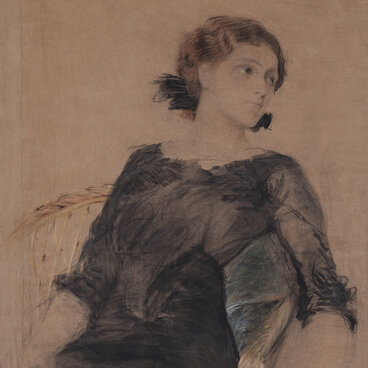The “Self-Portrait” is one of the seven paintings by Mitrofan Semyonovich Fyodorov in the collection of the Ostrogozhsk Museum of History and Art.
Mitrofan Fyodorov was a talented painter who languished in obscurity for many years. He was born into a large family of a village priest from Sitnikovo, Ostrogozhsky Uyezd, Voronezh Governorate in 1870. Following in the footsteps of his father, Mitrofan enrolled in the Voronezh Theological Seminary where he met Lev Grigoryevich Solovyov, a genius painter and a co-founder of a free drawing school in Voronezh. This meeting determined the fate of the young artist. In one of his later letters to Solovyov, the grateful student wrote, “If I had not met you, especially when I was so young and when my soul yearned for beauty as strongly as possible, then my life could have been completely different in terms of both form and substance.”
Having graduated from the theological seminary, Mitrofan Fyodorov chose not to go into the ministry but instead became a teacher. At the same time, he continued drawing. In 1894, Fyodorov entered the Academy of Arts, “My works were exhibited in the hall of the Council of the Academy, and newspaper critics praised them as remarkable. I was accepted among the first 5 out of 140 examinees.”
At the Academy, Fyodorov studied under Ilya Repin, Vasily Mate, and Pavel Kovalevsky. After graduating from the Academy, in 1901, he received the title of an artist and moved to Kharkiv. For many years, Fyodorov lived and worked there. Between 1902 and 1913, he taught painting and the history of art and was the chairman of the teaching council at the Kharkiv Art School. Between 1907 and 1914, the artist traveled abroad four times. During the Soviet period, he was a professor at the Kharkiv Art Institute. Mitrofan Fyodorov died of hunger in the besieged Leningrad in December 1941.
Mitrofan Fyodorov’s paintings are displayed in the Tretyakov Gallery, as well as various museums in St. Petersburg, Kyiv, Kharkiv, Voronezh, and Ostrogozhsk. Only a small part of Fyodorov’s works have survived to this day. Some of them disappeared during the Siege of Leningrad. Moreover, during the occupation of Ostrogozhsk, some of Mitrofan Fyodorov’s paintings were destroyed or stolen along with other museum exhibits.
Mitrofan Fyodorov was a talented painter who languished in obscurity for many years. He was born into a large family of a village priest from Sitnikovo, Ostrogozhsky Uyezd, Voronezh Governorate in 1870. Following in the footsteps of his father, Mitrofan enrolled in the Voronezh Theological Seminary where he met Lev Grigoryevich Solovyov, a genius painter and a co-founder of a free drawing school in Voronezh. This meeting determined the fate of the young artist. In one of his later letters to Solovyov, the grateful student wrote, “If I had not met you, especially when I was so young and when my soul yearned for beauty as strongly as possible, then my life could have been completely different in terms of both form and substance.”
Having graduated from the theological seminary, Mitrofan Fyodorov chose not to go into the ministry but instead became a teacher. At the same time, he continued drawing. In 1894, Fyodorov entered the Academy of Arts, “My works were exhibited in the hall of the Council of the Academy, and newspaper critics praised them as remarkable. I was accepted among the first 5 out of 140 examinees.”
At the Academy, Fyodorov studied under Ilya Repin, Vasily Mate, and Pavel Kovalevsky. After graduating from the Academy, in 1901, he received the title of an artist and moved to Kharkiv. For many years, Fyodorov lived and worked there. Between 1902 and 1913, he taught painting and the history of art and was the chairman of the teaching council at the Kharkiv Art School. Between 1907 and 1914, the artist traveled abroad four times. During the Soviet period, he was a professor at the Kharkiv Art Institute. Mitrofan Fyodorov died of hunger in the besieged Leningrad in December 1941.
Mitrofan Fyodorov’s paintings are displayed in the Tretyakov Gallery, as well as various museums in St. Petersburg, Kyiv, Kharkiv, Voronezh, and Ostrogozhsk. Only a small part of Fyodorov’s works have survived to this day. Some of them disappeared during the Siege of Leningrad. Moreover, during the occupation of Ostrogozhsk, some of Mitrofan Fyodorov’s paintings were destroyed or stolen along with other museum exhibits.



